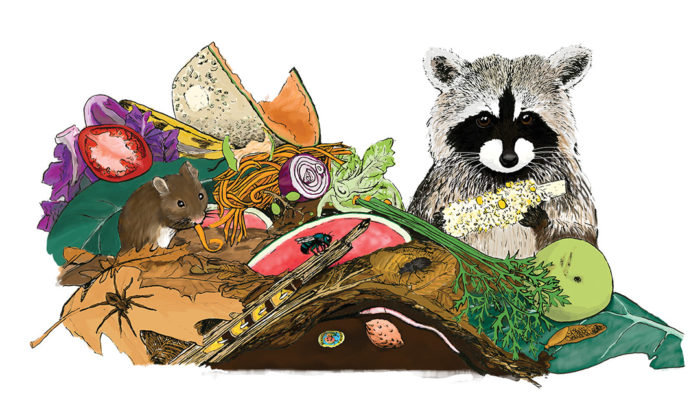
Contrary to popular belief, compost doesn’t “just happen.” Although, from the outside, you might see nothing more than a pile of rotting leaves and grass clippings, inside that pile a complex web of interactions is taking place. Tens of billions of microscopic creatures, from bacteria and fungi to nematodes and single-celled protozoa, call your compost pile home, and each one plays an important role in the creation of your coveted black gold. These organisms process the organic matter there, using the carbon and nitrogen in it to fuel their metabolism, growth, and reproduction.
In addition to all the organisms that we can’t see are many that we can. Compost piles and bins also host dozens of species of vertebrates and invertebrates, most of which are readily visible to the human eye. It’s easy to spot worms, insects, slugs, and small mammals scurrying about the compost bin, but it isn’t always easy to understand why they are there. Yes, some of them might cause your skin to crawl—maggots, anyone?—but they’ve all got important jobs to do. Many of these critters help the decomposition process in one way or another, but they can also tell you quite a bit about the state of your compost pile. Here are a dozen of the more common compost critters you’re likely to come across, along with a discussion of the role that they play and what their presence might be telling you.
Bees
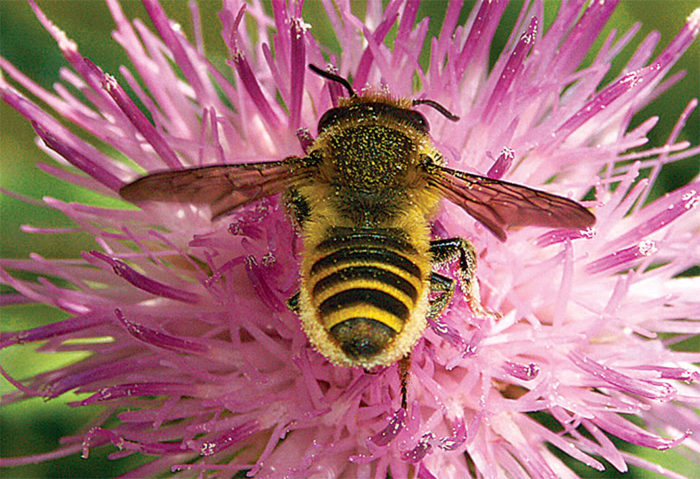
What they do: Although it is rare for European honeybees to build a comb inside a compost bin, sometimes gardeners might encounter some smaller species of native bees hanging out in a compost pile, particularly those that build their brood chambers in hollow plant stalks. North America is home to nearly 4,000 species of native bees, most of which live docile and solitary lives, nesting in hollow twigs, wood tunnels, or excavated ground burrows.
▶ What you should do: Sometimes certain native bee species will take up residence in the discarded perennial or bramble stems on top of a compost pile. These small nondescript bees are suffering from pesticide exposure and habitat loss—just as the imported European honeybees are—so allowing them to reside in your compost pile is a good thing. Most, by the way, do not sting.
Fruit flies
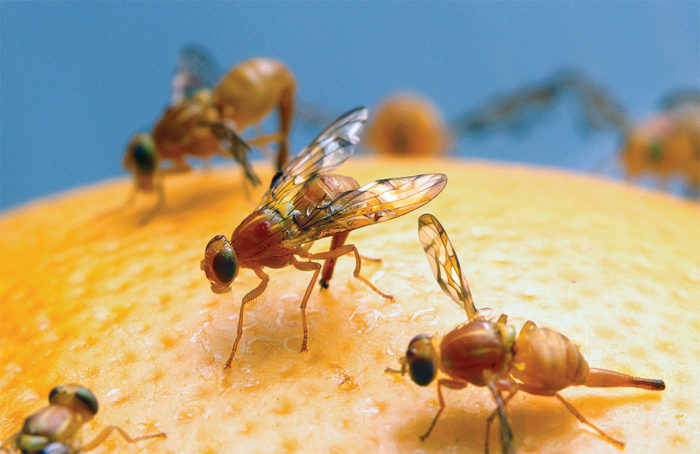
What they do: Fruit flies are tiny flies with prolific reproduction capabilities, completing their entire life cycle in about a week. They feed on overripe or rotting fruit and are more of a house pest than a garden pest. Because they are attracted to fermenting fruit, these flies are common finds in the compost pile, where you’ll often see them flying around discarded citrus rinds, banana peels, and other fruit trimmings. Females lay up to 500 eggs in their lifetime, and the resulting larvae feed just beneath the exterior of the fruit.
▶ What you should do: Although they are neither friend nor foe in the compost pile, fruit flies are annoying, readily flying up a nostril or into an open mouth every time the pile is disturbed. To rid your compost pile of this nuisance, be sure to bury fruit and vegetable scraps at least 6 inches deep or cover them with a few handfuls of brown leaves or straw.
Small mammals
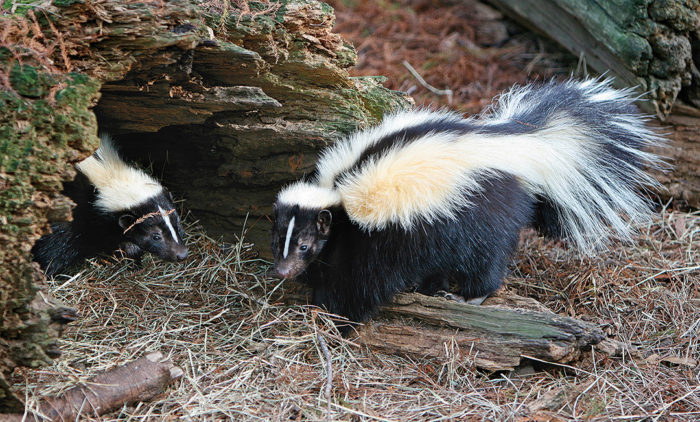
What they do: From time to time, gardeners might discover a variety of mammals in and around the compost pile. Some drop by in hopes of digging up an insect meal. Skunks, opossums, and armadillos are quite fond of the grubs, earthworms, and various insects buried in the pile. They occasionally scrounge around in the pile, turning it as they go. Some creatures might even take to nesting in your compost bin.
▶ What you should do: Mice and rabbits enjoy the warmth of the decaying materials and might build their nest along the perimeter of the pile or, if it isn’t actively “cooking,” right in the middle of it. This is easily prevented by regularly turning the pile to ensure that it is in an active state of decomposition. Some mammals, like raccoons, opossums, and rats, are attracted to the pile if eggshells, fresh corncobs, dairy products, meats, or other foods are regularly added. To prevent unwelcome visitors, avoid adding items like these to the pile.
Yellow jackets
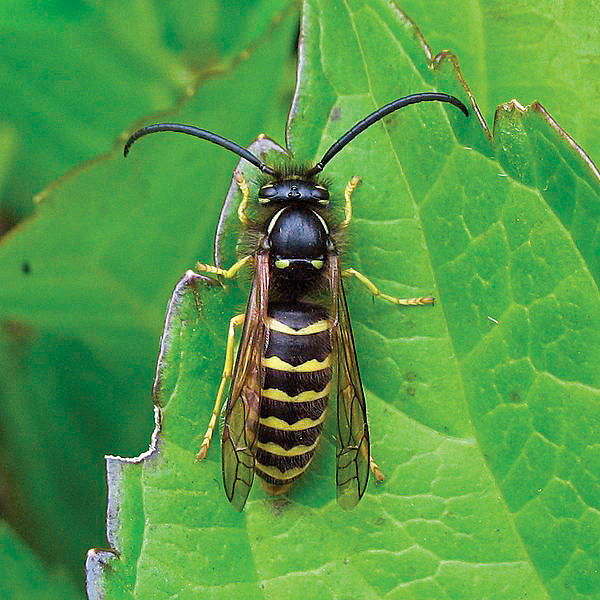
What they do: These social insects are often mistaken for bees, which they decidedly are not. The ground-dwelling species of yellow jackets, which sometimes take up residence in compost piles and bins, are, in fact, commonly called “ground bees,” although they are actually wasps. They can become rather aggressive in fall, stinging repeatedly. Ground-dwelling yellow jackets can become problematic in the compost pile if they decide to build a nest there.
▶ What you should do: Regularly turning the pile, starting in early spring, will prevent yellow jackets from building a nest. If, however, you neglect this chore and a nest is established, use commercial traps to capture them or leave the compost pile alone until the following year, when the abandoned nest can be safely removed.
Pill bugs and sow bugs
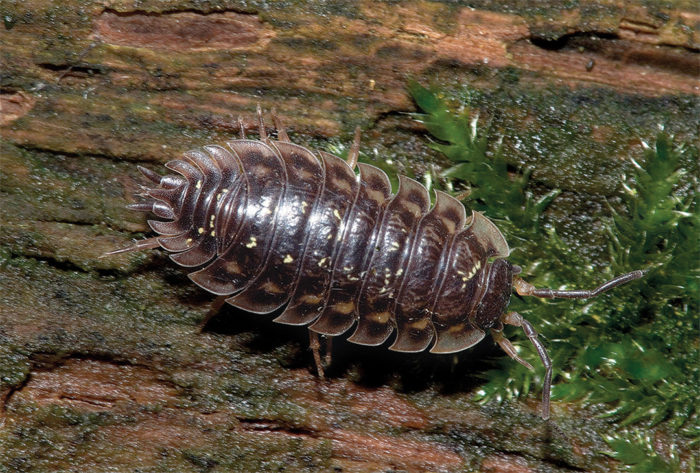
What they do: These creatures aren’t insects; they are land-dwelling crustaceans that are closely related to shrimp and crabs. Pill bugs and sow bugs are common throughout North America. Although these two creatures look alike, an easy way to distinguish them is to watch their behavior when disturbed. Pill bugs will curl into a tight ball (giving them yet another common name of “roly-polys”), while sow bugs (pictured) will simply scurry away.
▶ What you should do: Pill bugs and sow bugs are constantly hanging around the compost pile. This is because their primary food source is decaying plant material, although they will occasionally eat live plants. Because they breathe through gills, pill bugs and sow bugs need constant moisture. Too many of them in the compost pile might indicate that moisture levels are too high. Refrain from watering your pile for a while to let things dry out a bit.
Beetles and grubs

What they do: You aren’t likely to find in the compost pile the pest beetle species that commonly feed on your garden plants. Common to the compost pile—as both adults and larvae—are the many species of predaceous ground beetles (pictured) and rove beetles found in North America. These dark-colored beetles, often with hard, ridged wing covers, are nocturnal hunters that scour the ground or the compost heap for slugs, worms, insect larvae, and other critters. Gardeners occasionally might also find larval beetles from the scarab family (commonly called “white grubs”); although most feed on the roots of living turfgrass and ornamentals, one might find its way into the compost bin from time to time.
▶ What you should do: The presence of predaceous ground beetles is no cause for concern; you should, in fact, consider it a good sign. Having them around means that there is a lot of biological activity occurring in your pile. A healthy population of predators means a healthy population of all the insects they feed on, many of which are active decomposers. Spotting a few white grubs in the compost pile is also nothing to worry about. They are feeding on the roots of recently discarded plants and will not influence the health of the pile.
Slugs

What they do: North America is home to several dozen species of slugs. These terrestrial mollusks are relatives of octopi and clams, and they glide around the garden on a layer of protective mucus. Their mouths consist of an opening lined with tiny teeth capable of shredding their food in a cheese grater–like fashion. While some species prefer to feed on the fruit and leaves of living plants, most slugs are decomposers, perfectly at home in a compost pile full of organic matter ready to be consumed.
▶ What you should do: Slugs frequent compost piles often in the early stages of decomposition, before the pile heats up. Because slugs prefer moist conditions, the presence of large numbers of them might indicate that the pile is too wet. To remedy this, add more carbon-rich brown ingredients—such as autumn leaves, straw, or shredded newspapers—and stop adding additional water.
Ants
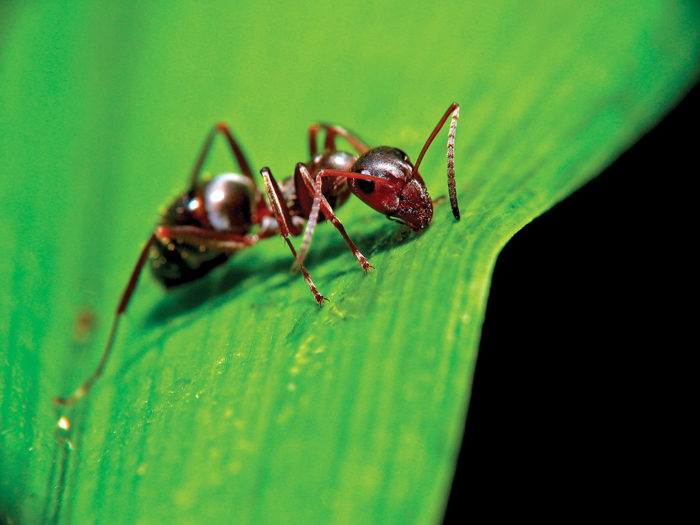
What they do: With upward of a thousand different species in North America, ants are among the most numerous insects in the garden. Each species has a different food preference: some are predaceous, while others are seed feeders or even omnivores that consume anything and everything they can find. Although ants are omnipresent in the garden and are generally no cause for worry, some species might take to eating young seedlings if a preferred food is unavailable.
▶What you should do: In the compost pile, ants are not a concern, simply serving as decomposers and aerators, although their presence often indicates that you are not turning your pile frequently enough or that it might be too dry. Hot, actively “cooking” compost piles are not a welcome place for an ant colony. Be sure to turn your pile every few weeks and to maintain the moisture level to that of a wrung-out sponge.
Worms
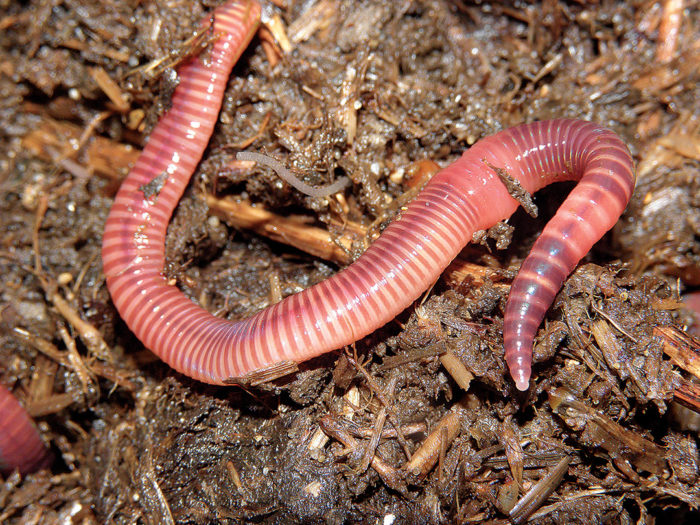
What they do: In a compost pile, worms act to shred organic matter and to provide aeration by opening tunnels. The mucus they exude helps soil and compost particles aggregate together. The bacteria living in their digestive system digests the bacteria, fungi, nematodes, and organic matter that worms eat, breaking chemical bonds and releasing nutrients to plants.
▶ What you should do: Although not all species of worms prefer the conditions of a compost pile, those that do are often found when the compost is nearing completion. Actively “cooking” compost can reach 120°F to 160°F, temperatures far above those preferred by worms. If the center of the pile is too warm, you might find some species around the pile’s exterior if the pile is not regularly turned. The presence of worms in the compost pile is generally considered to be a good sign.
Millipedes and centipedes
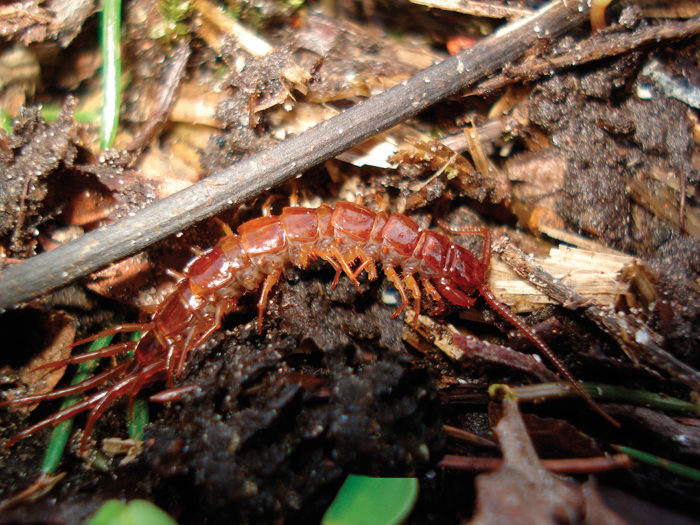
What they do: Although their names are similar and both are frequently found in compost piles, millipedes and centipedes are quite different from each other. While both have long, tube-shaped bodies comprised of ringlike body segments, that’s where the similarities end. Millipedes are round like a pencil and have two pairs of legs per body segment. When they are disturbed, millipedes often curl up into a tight spiral. True scavengers, millipedes feed mostly on decaying plant matter. Centipedes (pictured), on the other hand, have one pair of legs per body segment and are slightly flattened. Often reddish orange in color, centipedes are fast movers, promptly running away when disturbed. Centipedes are predators with a pair of poison-infused modified claws near their mouth that can “sting” humans if they are handled roughly, although, in most species, these claws are not strong enough to pierce human flesh.
▶ What you should do: Millipedes play an important role in the compost pile, breaking down organic matter and creating tunnels through which microbes can readily move around the pile. Centipedes eat various insects, spiders, slugs, and worms in the compost pile. Centipedes do not have a waxy covering over their skin, so they need moisture to survive. Large numbers of centipedes in the compost pile often indicate that the pile is too wet.
Spiders
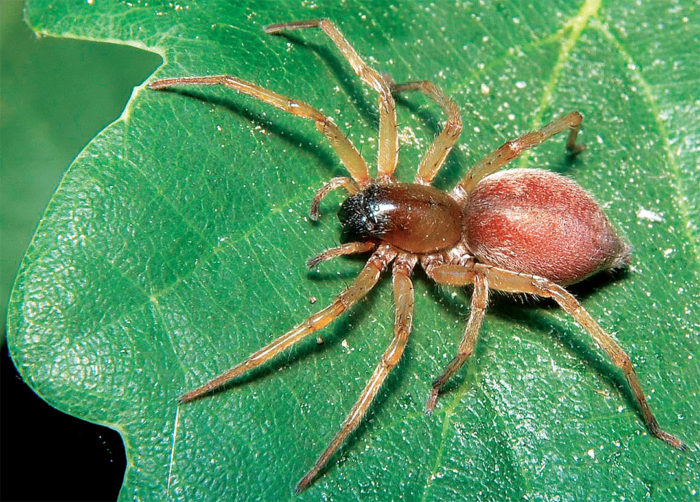
What they do: Spiders play a valuable role in the garden, catching and consuming many different pest insects. Although you aren’t likely to find aerial web-spinning spiders in your compost pile, you will often find several common cursorial species—including wolf spiders, jumping spiders, and sac spiders—scurrying about in search of prey. Even the occasional funnel-building web spinner might make a home toward the top of the pile.
▶ What you should do: The presence of spiders in your compost bin means nothing more than the presence of their prey. To discourage web builders, regularly turn the pile throughout the season. Spiders should be encouraged in the compost pile and elsewhere in the garden. If spiders give you the heebie-jeebies, try your best to ignore them and remember how good they are for the garden.
Flies and maggots
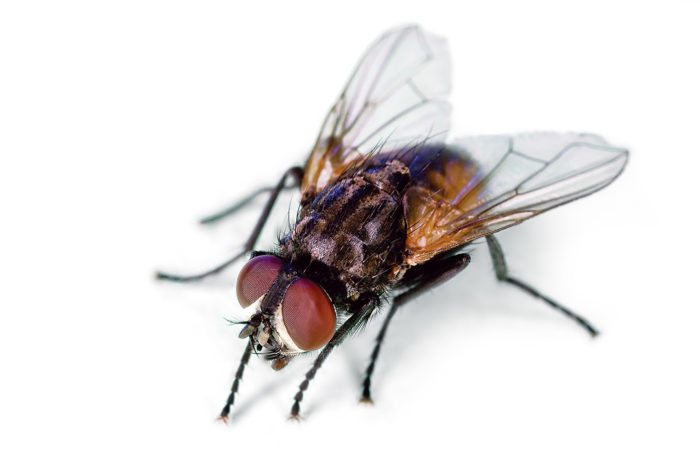
What they do: Flies are a diverse crew, with more than 120,000 species worldwide. As larvae (maggots), they might eat vegetable matter, carrion, or dung, or they might be predaceous. Those species most often found in compost piles are those whose larvae feed on either the manure or the kitchen scraps found there.
▶ What you should do: The presence of a large number of flies might indicate that inappropriate ingredients are being added to the compost pile. Carrion-eating species are attracted to meat, so never add meat products to your pile. Burying all kitchen scraps 6 to 8 inches deep, in fact, helps reduce all manner of flies in the compost pile. The most common fly species in compost is probably the black soldier fly (Hermetia illucens). Its large, plump, cream-colored maggots are noticeable and might cause some alarm when first discovered. Finding them in your pile isn’t a big deal, except for the “ick” factor. These maggots prefer moist compost piles, so adding more carbon-rich brown ingredients to dry out the pile and burying your kitchen scraps should be enough to deter them.
Fine Gardening Recommended Products
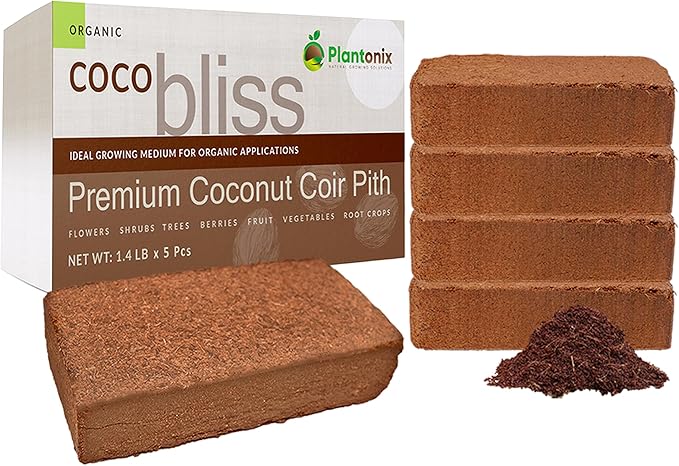
Coco Bliss 650gm Bricks (5-Pack) - Organic Coco Coir
Fine Gardening receives a commission for items purchased through links on this site, including Amazon Associates and other affiliate advertising programs.

A.M. Leonard Deluxe Soil Knife & Leather Sheath Combo
Fine Gardening receives a commission for items purchased through links on this site, including Amazon Associates and other affiliate advertising programs.

Fort Vee - Organic Potting Soil Mix
Fine Gardening receives a commission for items purchased through links on this site, including Amazon Associates and other affiliate advertising programs.




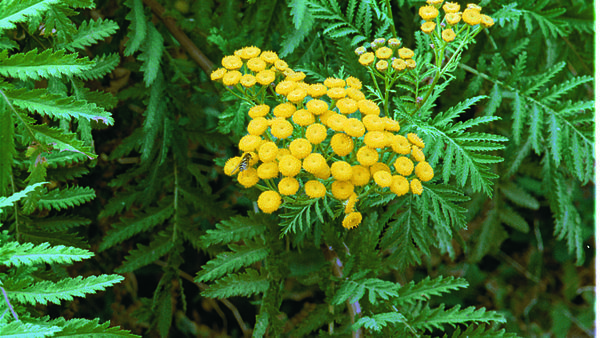













Comments
Great illustrations and photos.
Very informative article- I was especially happy to learn about the Pill Bug and the Sow Bug- I had no idea!!!!
Log in or create an account to post a comment.
Sign up Log in